 | ||
Little Egypt Dances for Edison (1896)
Little Egypt was the stage name for three popular belly dancers. They had so many imitators, the name became synonymous with belly dancers generally.
Contents
- Little Egypt Dances for Edison 1896
- Little Egypt Fatima Djemille 1896 Edison
- Fahreda Mazar Spyropoulos
- Ashea Wabe
- Fatima Djamile
- Legacy in film
- Legacy in music
- Legacy in literature
- References
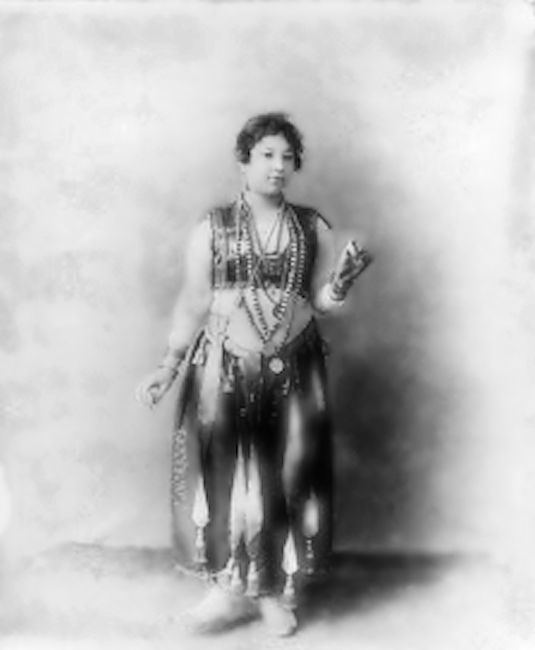
Fahreda Mazar Spyropoulos, (c. 1871 - April 5, 1937), also performing under the stage name Fatima, got her start at the Bird Cage Theatre in Tombstone, Arizona. In 1893 she appeared at the "Street in Cairo" exhibition on the Midway at the World's Columbian Exposition, held in Chicago. Mark Twain had a near fatal heart attack watching Farida go through her paces in 1898.
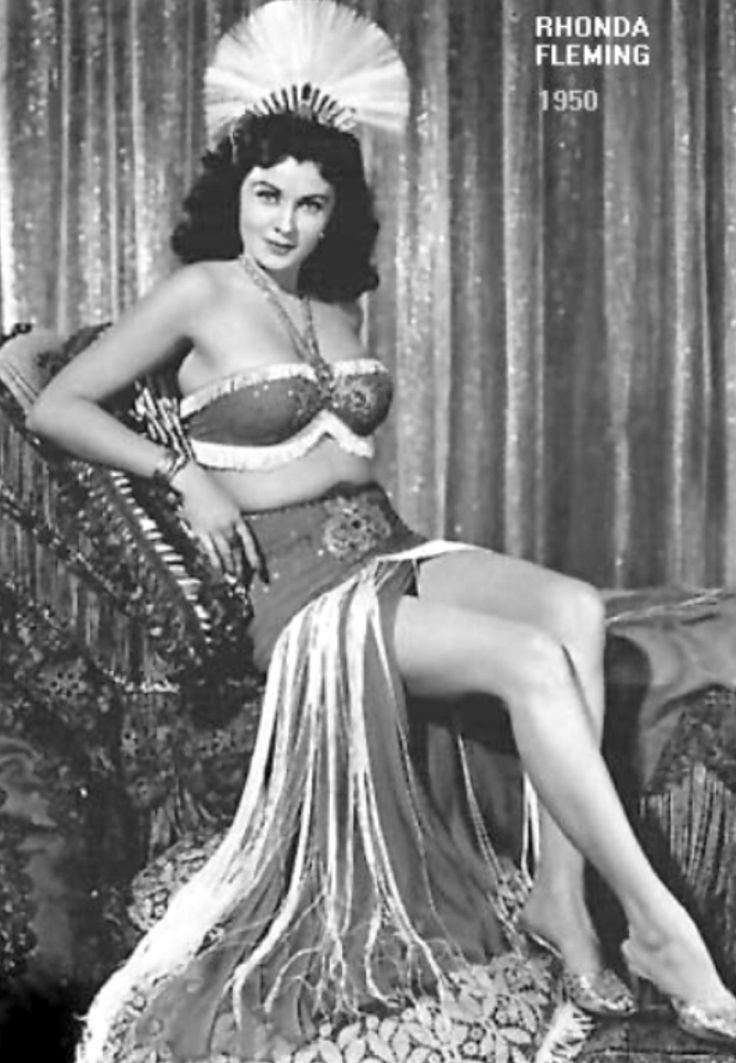
Ashea Wabe (born Catherine Devine (1871 - January 3, 1908) danced at the Seeley banquet in New York in 1896, enjoying a fleeting succès de scandale.

Fatima Djemille (died March 14, 1921) appeared at the 1893 Chicago World's Fair.
Little Egypt (Fatima Djemille) 1896 Edison
Fahreda Mazar Spyropoulos

Farida Mazar Spyropoulos, a belly dancer who went by the stage name of Fatima got her start at the Bird Cage Theatre in Tombstone, Arizona in 1881. In the reopened saloon's lobby hangs a larger-than-life sized painting she donated entitled "Fatima". It bears six patched bullet holes; one can be seen above the belly-button and a knife gash in the canvas below the knee.
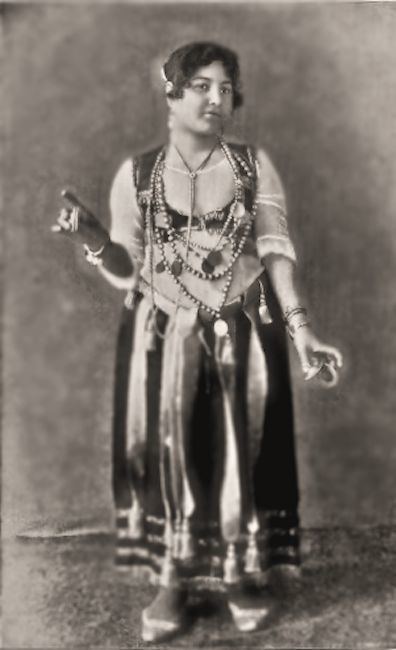
In 1893 Spyropoulos went to Chicago to appear at the World's Columbian Exposition. At the Egyptian Theater on the fair's Midway Raqs dancers performed for the first time in the United States. Sol Bloom presented a show titled "The Algerian Dancers of Morocco" at the attraction called "A Street in Cairo" produced by Gaston Akoun, which included Spyropoulos, though she was neither Egyptian nor Algerian, but Syrian. Spyropoulos, the wife of a Chicago restaurateur and businessman who was a native of Greece, was billed as Fatima, but because of her size, she had been called "Little Egypt" as a backstage nickname.

Spyropoulos gained wide attention, and popularized this form of dancing, which came to be referred to as the "Hoochee-Coochee", or the "shimmy and shake". At that time the word "bellydance" had not yet entered the American vocabulary, as Spyropoulos was the first in the U.S. to demonstrate the "danse du ventre" (literally "dance of the belly") first seen by the French during Napoleon's incursions into Egypt at the end of the 18th century.
Some time after the fair Spyropoulos went to Europe, and performed under the stage name "Little Egypt."
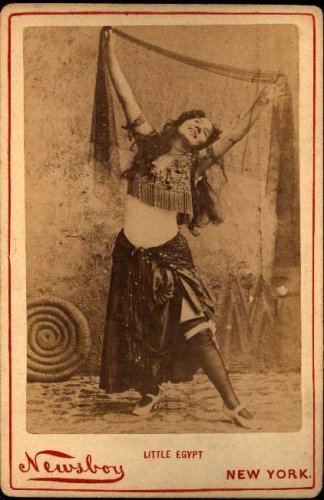
in 1896, Spyropoulos was arrested by New York City police. In a raid on the famous Sherry's restaurant, she was caught dancing her specialty, this time, stark naked, at a stag party given by the grandson of P. T. Barnum.
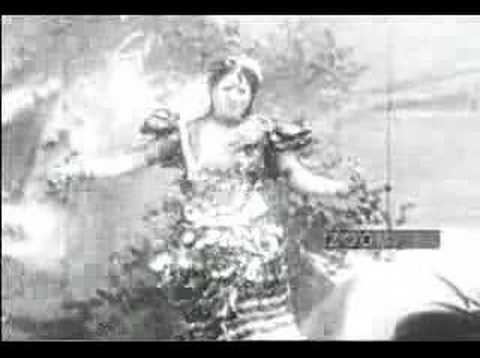
Subsequently, several women dancers adopted the name of Little Egypt and toured the United States performing some variation of this dance, until the name became somewhat synonymous with exotic dancers, and often associated with the Dance of the Seven Veils. Spyropoulos then claimed to be the original Little Egypt from the Chicago Fair. Recognized as the true Little Egypt, she always disliked being confused with Ashea Wabe, after Wabe's performance at the Seeley banquet in 1896 ended up in her arrest and a full-scale New York City scandal.
Spyropoulos danced as Little Egypt at the 1933 Century of Progress in Chicago at the age of 62.
At the time of her death, she had filed suit against Metro-Goldwyn-Mayer for the use of her name in the motion picture The Great Ziegfeld, claiming that the producers of the movie failed to ask her consent.
Ashea Wabe
Ashea Wabe became front-page news item in 1896 after she danced at a swank Fifth Avenue bachelor party for Herbert Seeley. A rival promoter reported that Wabe was going to dance nude and the party was raided by the vice squad. Though the raid precluded Wabe from completing her "act," she nonetheless admitted to local authorities that she had been paid to dance and pose "in the all-together," a euphemism for having no clothes on. Theodore Roosevelt, then a New York City Police Commissioner, supported the police captain who conducted the raid and who was subsequently vilified by the city media for interfering with a party held by upstanding gentlemen. Only later did the story come out that Wabe (a.k.a. Little India) had every intention of performing in the nude and would have done so had the police raid not occurred.
The raid brought some amount of fame to Wabe. She was hired by Broadway impresario Oscar Hammerstein I to appear as herself in a humorous parody of the Seeley dinner. She might have then been forgotten except for a series of photographs taken by Benjamin Falk.
On January 5, 1908, she was found dead in her apartment at 236 West 37th Street, New York City, by her sister, having apparently died from gas asphyxiation. She was said to have left an estate of over $200,000.
Fatima Djamile
Fatima was the subject of two early films, Edison's Coochee Coochee Dance (1896) and Fatima (1897).
Legacy in film
Legacy in music
Legacy in literature
Loving Little Egypt is the title of a Thomas McMahon novel, set in the late 19th century.
